INSIDE THE BATMAN: Steve Englehart explains how the return of Deadshot was an unexpected move – and how he was able to deepen Bruce and Silver’s love affair…
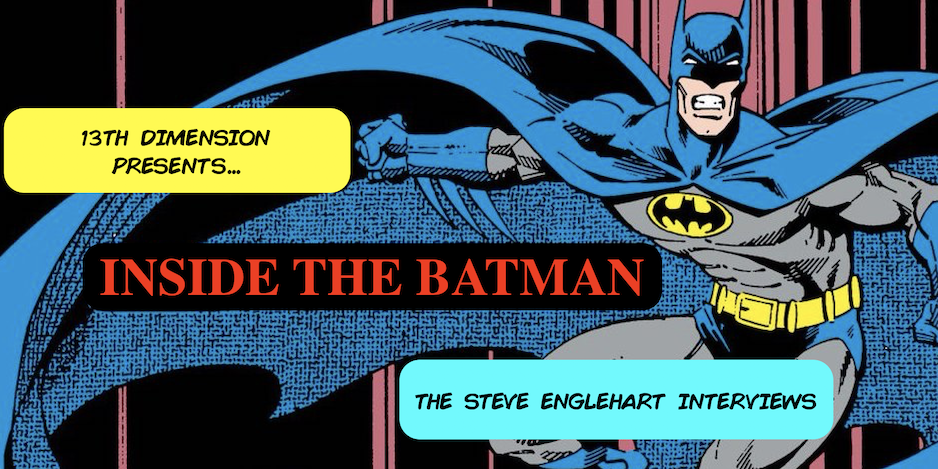
Welcome to INSIDE THE BATMAN: THE STEVE ENGLEHART INTERVIEWS, an issue-by-issue exploration of the greatest Batman story of all time — Steve Englehart and Marshall Rogers’ seminal late ’70s Detective Comics run. The complete story has finally been collected for the first time in hardcover — and in the way Englehart envisioned it — in Tales of the Batman: Steve Englehart. With the book newly released, the time is perfect to go back and look at the story from every conceivable angle. Each weekend this summer, we’re diving into a single chapter of the 8-issue saga, with full commentary by Englehart himself — the most complete analysis of the landmark storyline ever published. For the INDEX of individual entries, click here.

So far, we’ve covered how Steve Englehart landed the gig, what he set out to accomplish, what his overarching thoughts are on Batman and the Joker, the Darknight Detective’s sex life, the change in art teams from Walt Simonson and Al Milgrom to Marshall Rogers and Terry Austin and how he structured the story. (Click here.) We’ve also explored the story’s first five issues — Detective Comics #469 (click here), Detective #470 (click here), Detective #471 (click here) and Detective Comics #472 (click here), Detective Comics #473 (click here), which gave us Silver St. Cloud, Rupert Thorne, Dr. Phosphorus, the return of Hugo Strange after nearly 40 years, and the Penguin.
As we’ve established in previous installments of INSIDE THE BATMAN: THE STEVE ENGLEHART INTERVIEWS, the writer’s classic Detective Comics arc was originally planned for seven issues. But after the sales numbers started coming in for the first two, DC decided to extend the story with an eighth chapter.
Englehart wasn’t pleased – at first. But ultimately, 1977’s Detective Comics #474 became a crucial character study of Bruce Wayne and Silver St. Cloud’s relationship — culminating in her startling epiphany that Bruce and Batman are the same man. And, perhaps more famously, it reintroduced and revamped one-off villain Deadshot, who more than 40 years later has become one of DC’s most popular baddies, on page and screen.
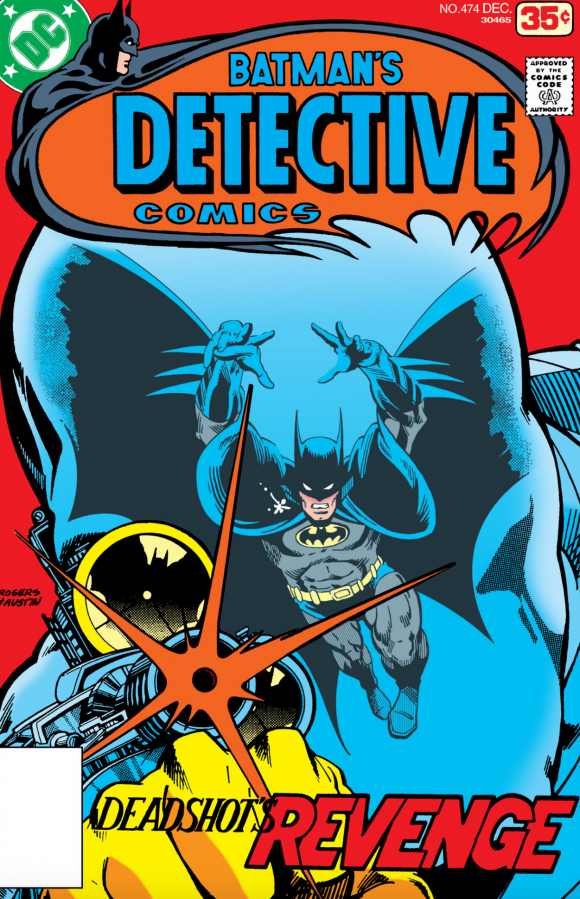
Dan Greenfield: This is the issue that was added to the original story, the Deadshot issue. It was the sales, right, that drove them to add another chapter to the story? How did you figure out how to re-jigger things?
Steve Englehart: (After the first two chapters), I had it all worked out in my head as to how it was going to work in five more issues. Then they said, “Oh, you could have one more issue. Then I was able to take some of those plot points and stretch them out and let them breathe. Like when Bruce and Silver were having lunch at the fancy place and they’re just talking about stuff — things like that where I could just have the characters, they didn’t have to be moving the plot forward the whole time. In five issues they pretty much had to do that. With six issues, all of a sudden they could expand a little bit, they could relax, and they could do this, so that was cool.
Something I said a lot in terms of Captain America is that Captain America went from a book that was facing cancellation to Marvel’s No. 1 book in six months. People go, well, how the hell is that possible? The answer was it was all on newsstands, and we had three quarters of a million to a million people reading this stuff and responding to it through the mail.
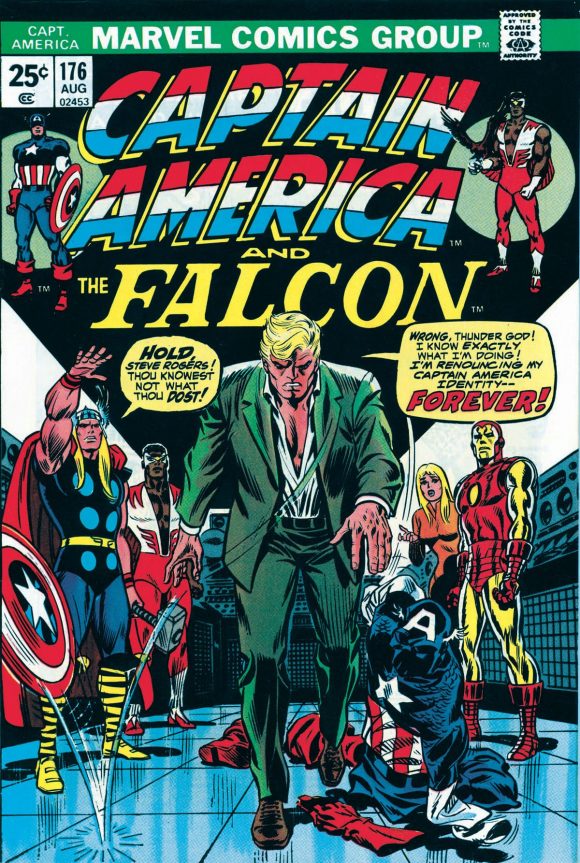
If a book started to do well, if a book was entertaining, people would tell their friends, and their friends would go buy it and they were all on newsstands so they could buy it, and then sales could go like that and change so dramatically. That’s what happened here.
The early issues sparked something in readers, and DC’s looking at the numbers and going oh, well this book is selling better. I think it was bi-monthly except one extra issue in the summertime, and they turned it into two extra issues in the summertime or something like that.
Anyway, Julie said “We’re gonna do an eighth issue,” and my first thought was, “Well, fuck no,” because it was planned for seven. But then I thought, “Well, fine. So I’ll take the last two, I’ll move them out so they’ll stay the last two, but now I’ve got this extra issue to like open up some stuff.”
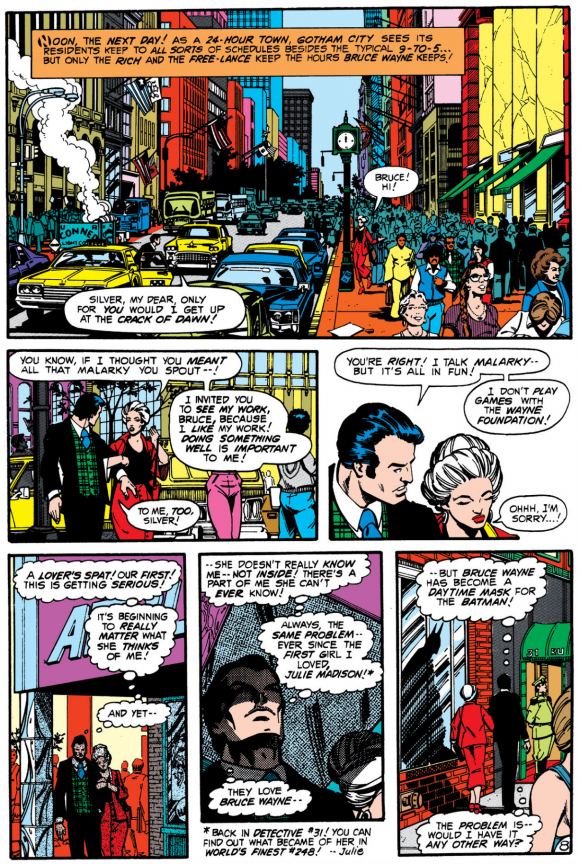
So in the previous issue we just saw, as you mentioned, one page with Silver St. Cloud. But here, that whole scene in the restaurant, I could spread that out. That could let them breathe, and they could talk to each other, which was great because they’re supposed to be lovers, right?
So having quick meetings where she’s happy to see him and he hugs her and all that, that advances the story but just being able to sit there and talk makes it more intimate. Makes it more believable that those two actually have something going on.
Dan: We also get to see her as a fully formed career woman. We get to see her at work, which is something that you didn’t typically see. You usually see the damsel in distress, but here’s Silver in her element, and of course it’s a great homage to old Batman comics with the gigantic typewriter and all that fun stuff. This is really in my mind the issue where Silver fully blossoms into this completely well-rounded character. You said at the beginning that you set out to make her worthy of Batman, that she would have to be smart, she would have to be driven, she would have to have these characteristics.
In the lunch scene, their body language is brilliantly constructed — whether that was your doing or Marshall’s doing or a combination of both — but it’s just that you get a whole lot about her and their relationship in this story that really gets to breathe, that I don’t think you would have had if it had been only seven issues.
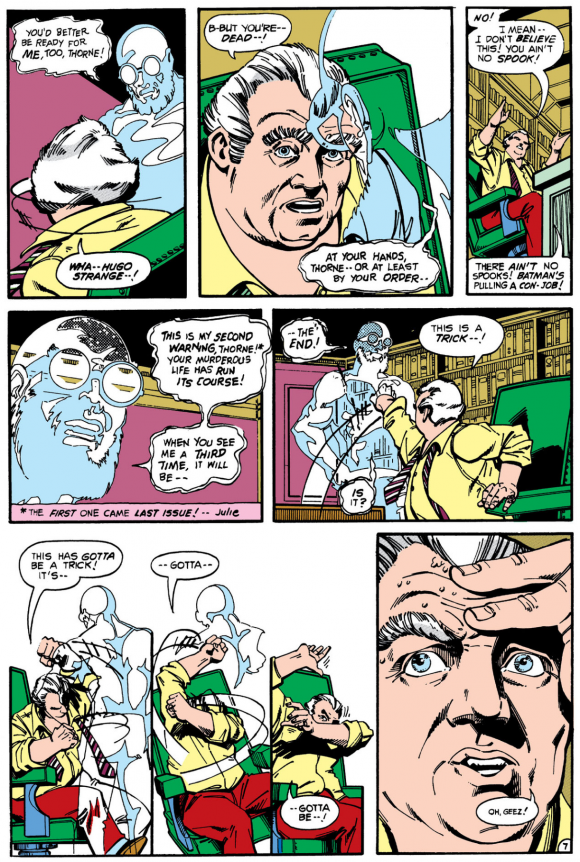
Steve: No. The Deadshot stuff is added in, and then the scene where Deadshot’s in prison with the Penguin gives us a chance to just see the Penguin one more time having lost, having been thrown into prison, but that’s definitely an added scene. That wasn’t part of the thing. I noticed that Boss Thorne and the Batman and the ghost of Hugo Strange get three pages here, all that stuff, it all runs longer than it would have, but it allows us to get deeper into the characters…
I could have done the Batman in seven issues. I was planning to do the Batman in seven issues. We would have covered the same ground, but we wouldn’t have gotten as deeply into some of these guys. You said the Penguin thing was kind of a break, the lightest issue. This is kind of a break psychologically, in that people get to kind of like chill a little bit. Deadshot’s not that big compared to the Joker and the Penguin, Deadshot’s not that big a guy, so we’re looking at the other aspects of the story here and we’re getting a chance to do that. So I’m happy to suddenly be told, “Oh, now you can spread some of this stuff out.” The ghost is in there, Silver’s in there, she’s got a job. We don’t even get to Deadshot for quite some – (pauses, looking at the book) – oh, I love this panel!
Dan: Which one?
Steve: When they’re in the restaurant, and it’s two panels but it’s one scene and he’s thinking, thinking, thinking, and she’s just sitting there looking at him.
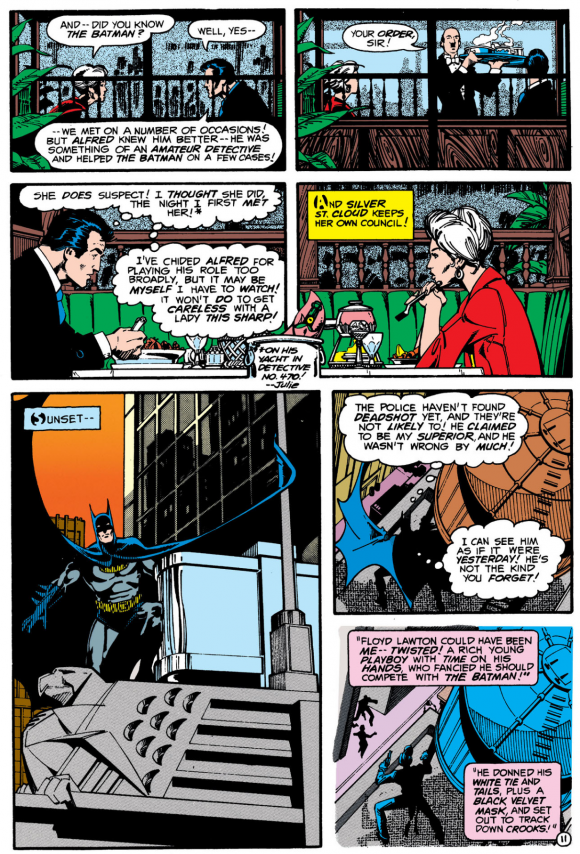
Dan: It’s two panels but it’s really one, where she’s just looking at him. He’s eating and thinking and eating and trying to play it cool, she’s staring at him intently and the way even her body language, the fork just hanging out of her hand, she doesn’t care about what she’s eating. All she wants to know is more about this guy who she’s really intrigued by. He on the other hand is like, “Uh-oh, this is getting a little close and I’m not sure how I feel about this.”
Steve: Yeah. It’s so nice. The art is so nice here. Marshall’s sense of body language and all that. There’s still some Calculator-era art in here, things that look a little simplistic or angular or whatever, but he’s getting more control of all this stuff all the time. This whole scene in the restaurant is just so nicely laid out and the body language, as you say, is just great.
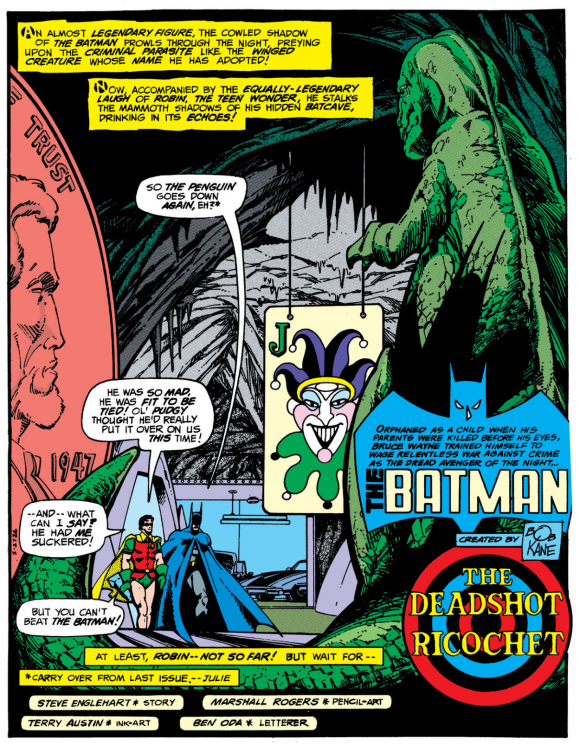
Dan: Before we do talk about Deadshot, what I also love about this issue is how it wraps up the Batman and Robin segment in the story. You get their sparring match in the Batcave, and for me as a reader, it really does make me miss the days where Bruce and Dick’s relationship was a friendship — it was trusted, it was mentor-protégé.
I don’t know how familiar you are with comics now or the way it’s been over the last 25-30 years, actually closer to 40 now, but their relationship has become fraught with mistrust and disappointment and there’s a lot of friction there. To me it’s so refreshing that they’re just friends, and you would think really that that’s what they would be. I’m looking at it from the vantage point of 40-some-odd years later, but when you were writing this scene, allowing the characters to breathe, just talk a bit about this whole sequence.
Steve: Well, I agree with you. In that sense I’m a dinosaur, in that to me Batman and Robin are friends. I come in here now and they go well now he’s grown up and he has his own thing and all that kind of stuff, but as I said I wanted him in there and I wanted to show that friendship relationship.
I like when the characters, if they’re disposed to be, if they’re not enemies, that they can be friends. Being friends is a thing. I recognize that over the years since then, the world’s gotten bleaker and less upbeat and a lot of people doing comics since then have gone for more friction and battle and distrust and all the stuff you just mentioned. I’m not denigrating that — you write for the era you’re in, you write for all that kind of stuff. This is my dinosaur era here, where they were just pals.
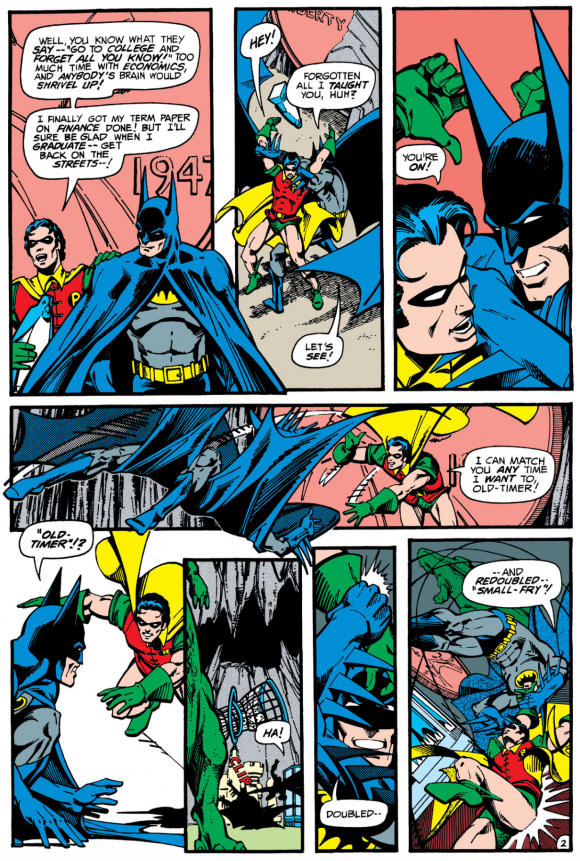
So much of what had gone before (this run) was just filler. We talked about The Joker’s Five-Way Revenge (by Denny O’Neil and Neal Adams in 1973’s Batman #251), that wasn’t filler, but it wasn’t pulp either. A lot of the Batman stuff had just been like, getting out an issue every month and it didn’t mean anything in the great scheme of things.
I was trying, when I was summing up my Batman, it was like summing up the bits from the last 30-40 years, however old I was, that I thought worked for the Batman. I didn’t have to take into account stuff that was going to be written 20 years later. This is the Batman and Robin that I like. They went through so much stuff… well, I could go on and on. I don’t know why they’d be enemies, or anything other than this. So this is my definitive take on what I think the Batman is as per 1976. Then people did what they did after that. I wanted him in there. If he was there he couldn’t just disappear, so then he had to say goodbye, to my mind. So we got a chance for them just to talk a little bit and show off what Robin learned from Batman and all that kind of stuff. That’s it.
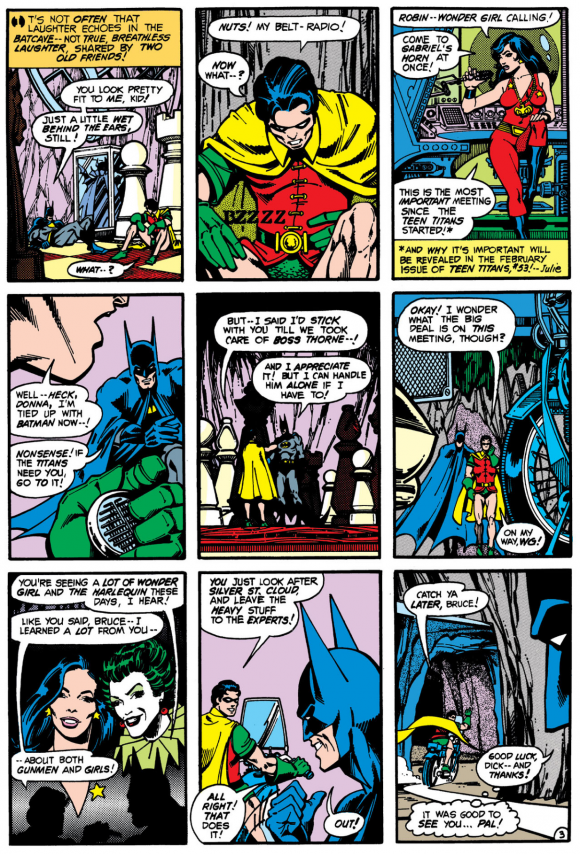
Dan: On to Deadshot himself. Hugo Strange has his roots in the early years of Batman, and the Joker and the Penguin speak for themselves. You also have these other characters that you created — Doctor Phosphorus, Silver and Rupert Thorne. Deadshot was a nobody. How of all of the villains that were basically one-offs did you come up with using Deadshot? Now, it seems like a fait accompli because hindsight’s 20/20, but at that time to come up with that specific guy, why him?
Steve: Julie suggested him. When Julie said we’re gonna do another issue, I’m sure I said, “Oh, well, then I need another villain,” and Julie said Deadshot. Which meant nothing to me. I did not remember Deadshot and none of us get to ask Julie now why he thought of Deadshot, right? But it was Julie’s idea.
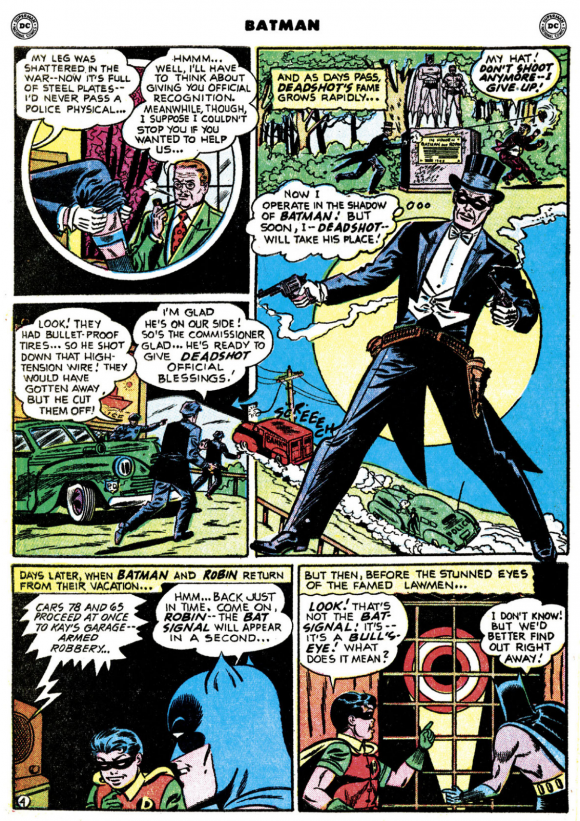
1950’s Batman #59: Deadshot’s debut
I mean he was a very obscure and not particularly important character, so why Julie suggested him I don’t know. In his original incarnation, he wore a tuxedo and six guns. You know, it was the ’50s. I looked at the original issue and I go, “Well, I don’t think there was anything there that I could draw on.” So, we basically just recreated the whole guy, which leads back to my bitching from last week that we don’t get any credit for this, because he pre-existed even though it’s a completely new guy. He’s called Deadshot, so we don’t get anything. I took what was there and then Marshall did the complete redesign.
Dan: That’s what I was going to ask, who designed the look? That was all Marshall?
Steve: All Marshall, yeah.
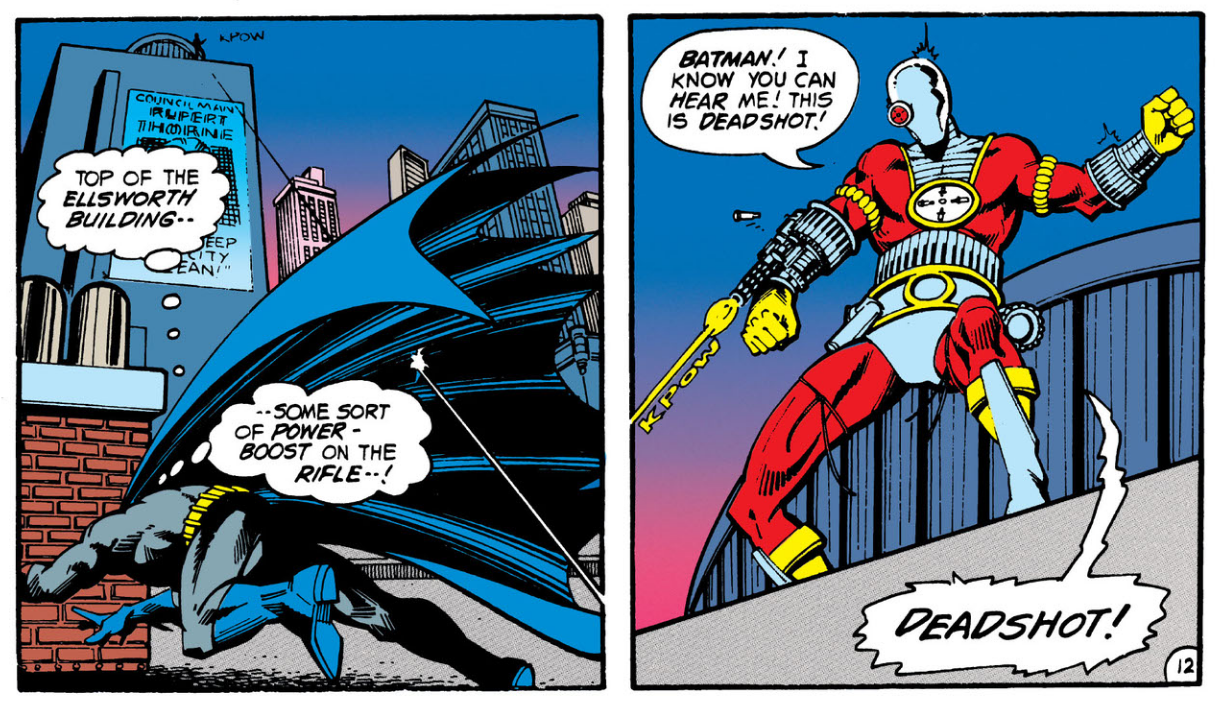
Dan: And it’s such a striking design. With Dr. Phosphorus, you obviously had an idea in mind, the idea that his skin was burning and he was skeletal and all of that. This is such a wild design. Again, going back to that experience that you had when you saw these issues for the first time, you had written Deadshot without a design basically, and then you saw what Marshall had done. Give me your take on that.
Steve: I had not seen this costume before I got the issues. I’m not sure how many costumes Marshall had designed by this point, but certainly not many and this was obviously something that he really put thought into. The fact that he can shoot by sort of pointing his arm at you and the gun goes off, that might have been mine; I might have had that idea ’cause I didn’t want him to be pulling six-guns out of a holster. But the design of the whole thing is Marshall and it’s a good costume. I’m looking at his chest and it looks like he’s got kind of a clock on it and I’m not exactly sure what that —
Dan: I think it’s supposed to be crosshairs.
Steve: OK. Well, I’m not entirely sure about that. But the whole thing with the one eye and the silver head and all that, that’s a complete redesign. That’s Marshall, doing his thing.
—
NEXT: PART 7, DETECTIVE COMICS #475: THE LAUGHING FISH — and How to Make THE JOKER Truly Insane. Click here.
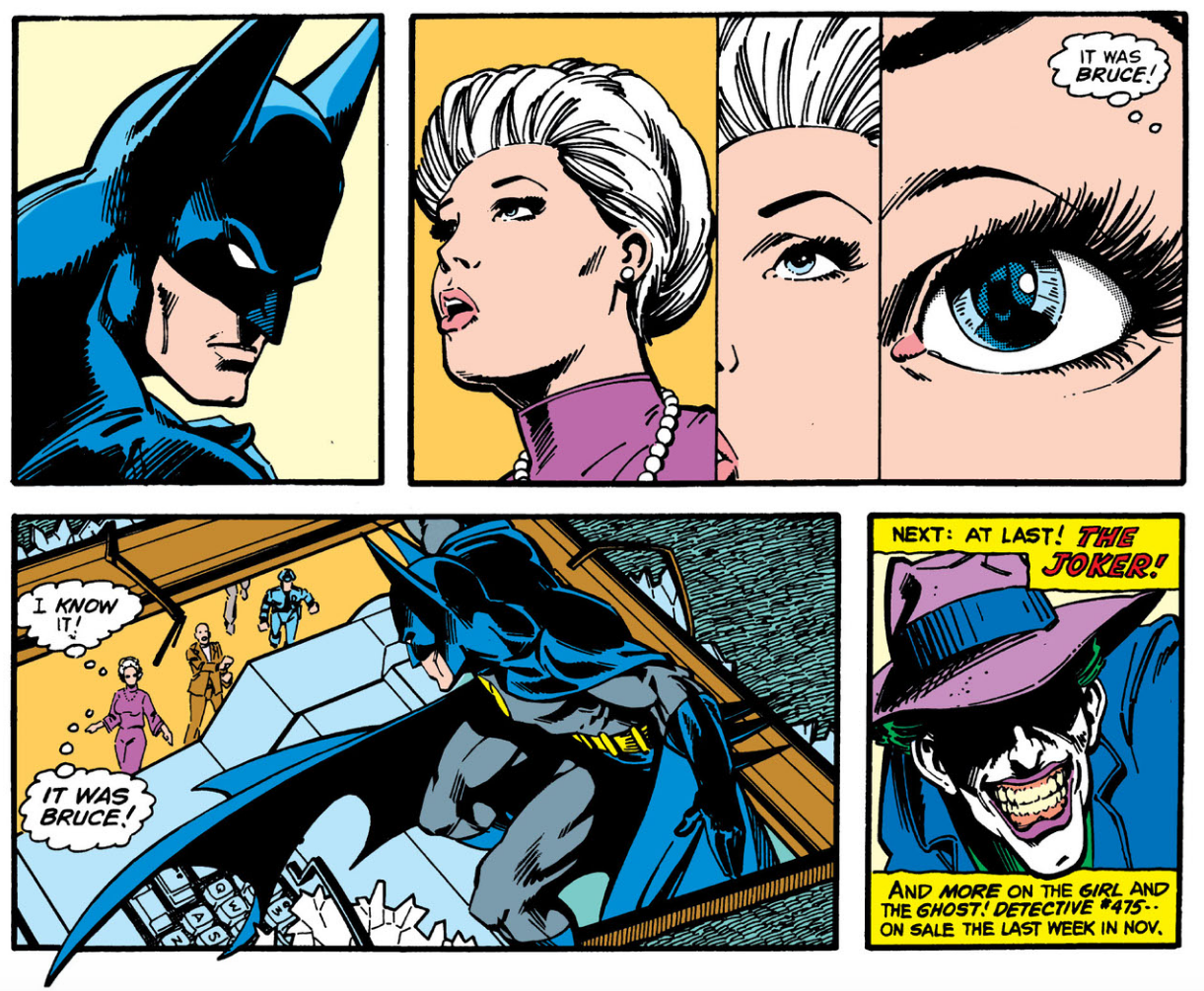
—
MORE
— INSIDE THE BATMAN: THE STEVE ENGLEHART INTERVIEWS Complete INDEX. Click here.
— PART 5: DETECTIVE COMICS #473 — The Importance of the DYNAMIC DUO — and THE PENGUIN. Click here.

August 2, 2020
A couple thoughts here, why does it seem such a thing that comic publishers treat their creators so poorly? Even in a time where DC was already getting called out for their treatment of Joe and Jerry, they never learn or change. So, much of this run should be properly credited but isn’t. Eg Deadshot, Thorne Why is that?
Second, this run really answers the question for me as to what sells a story, the story sells the story. In our modern day of overly polished art, the stories of the New 52 or even now are so, so bad. And, yet when the two come together like this duo here, you get a classic run like this.
I’m one of those dinosaurs too I guess. I miss BATMAN and Robin. I’ve lost count how many Robins there are now. To me, after the Bronze Age, comics have jumped the shark.
August 2, 2020
I agree with Buck. Too many Robins and too many Flash variants. I don’t like a lot of current artwork – some is excellent like Mike Allred. But so much of it has that sort of generic Manga look and the stories are really not very good at all. I’m a dinosaur too but Englehart’s work in Detective and JLA was superb. Amazing that it was so long ago – feels like yesterday. For me comics stopped being fun after the Bronze Age ended with some exceptions here and there. Everything got too nihilistic and dark.
By the 90 and Kelley Jones’ artwork on Batman (which I couldn’t stand) I stopped collecting and didn’t pick up until Jim Lee’s run around 2005. And when the New 52 started and they rebooted everything at #1 (I HATE #1 issue reboots) I stopped completely getting new comics for the most part (except Batman ’66).
August 2, 2020
I really and truly appreciate how Mr. Englehart is interviewed here.
August 3, 2020
Interesting to find out this was a “bonus” story. Even now I remember the character moments from this issue better than the action bits: Robin’s exit scene & (especially) the Penguin/Deadshot scene. It all flowed so well from the end of the Penguin story, it doesn’t feel shoe-horned in.
August 3, 2020
That Batman/Robin sequence might be my favorite interaction between those two characters in any comic. Englehart did incredible work on his Batman issues, and Rogers’ art was spot on. Easily a contender for ‘definitive’ Batman in my mind.
September 18, 2020
I remember reading somewhere that, had Englehart known of this” Bonus Issue, ” he would have used the Riddler !! Is this correct??